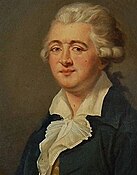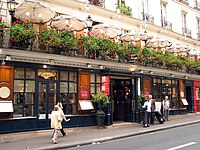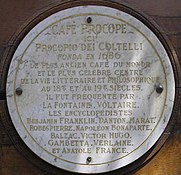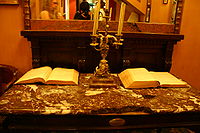Café Procope
48°51′09″N 2°20′20″E / 48.852496°N 2.338811°E

The Café Procope (French pronunciation: [kafe pʁokɔp]), also known as Le Procope ([lə pʁokɔp]), on the Rue de l'Ancienne Comédie, is a café in the 6th arrondissement of Paris. The original café was opened in 1686 by the Sicilian chef Procopio Cutò (also known by his Italian name Francesco Procopio dei Coltelli and his French name François Procope);[1] it became a hub of the Parisian artistic and literary community in 18th and 19th centuries. It sometimes is erroneously called the oldest café of Paris in continuous operation; (the Queen's Lane Coffee House in Oxford England has been in continuous operation since 1654) [2] however, the original café closed in 1872 and the space was used in various ways before 1957, when the current incarnation (not a café but a restaurant) was opened; so the claim of "oldest café in continuous operation" is not supported.[3]
Background
[edit]Procopio Cutò first apprenticed under the leadership of an Armenian immigrant named Pascal[citation needed] who had a kiosk (une loge de la limonade, English: lemonade stand) on rue de Tournon selling refreshments, including lemonade and coffee.[4] Pascal's attempt at such a business in Paris was not successful and he went to London in 1675, leaving the stall to Procopio.[5][6][page needed]
History
[edit]Cutò relocated his kiosk in 1686 to rue des Fossés-Saint-Germain-des-Prés.[7] At the beginning, it was referred to as an "antre" (cavern or cave) because it was so dark inside, even when there was bright sunshine outside.[8] Cutò purchased a bath house and had its unique fixtures removed; he installed in his new café items now standard in modern European cafés (crystal chandeliers, wall mirrors, marble tables).[9]
It was a place where gentlemen of fashion might drink coffee, the exotic beverage that had previously been served in taverns, or eat a sorbet, served up in porcelain cups by waiters in exotic "Armenian" garb.[10][page needed] The escorted ladies, who appeared at the Café Procope in its earliest days, soon disappeared.

In 1689, the Comédie-Française opened its doors in a theatre across the street from his café – hence the street's modern name.[11] By this stroke of fortune, the café attracted many actors, writers, musicians, poets, philosophers, revolutionaries, statesmen, scientists, dramatists, stage artists, playwrights, and literary critics.[11][12] It was to the Procope, on 18 December 1752, that Rousseau retired, before the performance of Narcisse, his last play, had even finished, saying publicly how boring it all was on the stage, now that he had seen it mounted.[13]
It was the unexampled mix of habitués that surprised visitors, though no-one remarked on the absence of women. Louis, chevalier de Mailly, in Les Entretiens des caffés, 1702, remarked:
The cafés are most agreeable places, and ones where one finds all sorts of people of different characters. There one sees fine young gentlemen, agreeably enjoying themselves; there one sees the savants who come to leave aside the laborious spirit of the study; there one sees others whose gravity and plumpness stand in for merit. Those, in a raised voice, often impose silence on the deftest wit, and rouse themselves to praise everything that is to be blamed, and blame everything that is worthy of praise. How entertaining for those of spirit to see originals setting themselves up as arbiters of good taste and deciding with an imperious tone what is over their depth![14]
In 1702, Cutò changed his name to the gallicized François Procope, and renamed the business to Café Procope, the name by which it is still known today. Prior to that, it had been known only as the "boutique at the sign of the Holy Shroud of Turin", which was the name of the previous business at the location.[15][16][2]
Throughout the 18th century, the brasserie Procope was the meeting place of the intellectual establishment, and of the nouvellistes of the scandal-gossip trade, whose remarks at Procope were repeated in the police reports.[17] Not all the Encyclopédistes drank forty cups of coffee a day like Voltaire, who mixed his with chocolate, but they all met at Café Procope, as did Benjamin Franklin,[18] John Paul Jones and Thomas Jefferson.
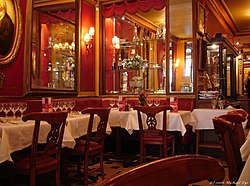
There are words above the door at Cutò's establishment that read: Café à la Voltaire.[11] Voltaire is known to have said, "Ice cream is exquisite. What a pity it isn’t illegal."[19]
The birthplace of the Encyclopédie, conceived by Denis Diderot and Jean le Rond d'Alembert, is said to be at Café Procope.[20]
Alain-René Lesage described the hubbub at Procope in La Valise Trouvée (1772): "There is an ebb and flow of all conditions of men, nobles and cooks, wits and sots, pell mell, all chattering in full chorus to their heart's content",[21] indicating an increasingly democratic mix. Writing a few years after the death of Voltaire, Louis-Sébastien Mercier[22] noted:
All the works of this Paris-born writer seem to have been made for the capital. It was foremost in his mind when he wrote. While composing, he was looking towards the French Academy, the public of Comédie française, the Café Procope, and a circle of young musketeers. He hardly ever had anything else in sight.
During the Revolution, the Phrygian cap, soon to be the symbol of Liberty, was first displayed at the Procope. The Cordeliers, Robespierre, Danton and Marat all used the café as a meeting place. After the Restoration, another famous customer was Alexander von Humboldt who, during the 1820s, lunched there every day from 11am to noon. The Café Procope retained its literary cachet; Alfred de Musset, George Sand, Gustave Planche, the philosopher Pierre Leroux, M. Coquille, editor of Le Monde, Anatole France and Mikael Printz were all regulars. Under the Second Empire, August Jean-Marie Vermorel of Le Reforme or Léon Gambetta[23] would expound their plans for social reform.
In the 1860s, the Conférence Molé held its meetings at the Café Procope. Léon Gambetta, like many other French orators, learned the art of public speaking at the Molé. Other active members during this period included Ernest Picard, Clément Laurier and Léon Renault.[24]
A plaque at the establishment claims that it is the oldest continually-functioning café in the world.[25]
Café Procope. Here founded Procopio dei Coltelli in 1686 the oldest coffeehouse of the world and the most famous center of the literary and philosophic life of the 18th and 19th centuries. It was frequented by La Fontaine, Voltaire and the Encyclopedistes: Benjamin Franklin, Danton, Marat, Robespierre, Napoleon Bonaparte, Balzac, Victor Hugo, Gambetta, Verlaine and Anatole France.
However, the claim is not entirely true. The original Café Procopes closed its doors in 1872, and the property was acquired by a woman by the name of Baronne Thénard, who leased it to a Théo Bellefonds, under the condition that he preserved the café's atmosphere. Bellefonds opened a private artist's club and established a journal entitled Le Procope, neither of which were very successful.[26] The premises then became the Restaurant Procope,[27] and in the 1920s, it was changed back to a café called Au Grand Soleil. At some point, a new owner realised the marketing value of the original name and rechristened it Café Procope.[26] In 1988–89, the Café Procope was refurbished in an 18th-century style.[2]
Gallery
[edit]-
Francesco Procopio
dei Coltelli – founder -
St. Germain des Prés – Café Le Procope
-
Café Procope, photo of the entrance at Cour du commerce Saint-André
-
Café Procope bar
-
First public café in Paris
-
World's oldest café
-
Plaque commemorating Benjamin Franklin's preparation of a Franco-American alliance in the café
-
Voltaire's desk
See also
[edit]References
[edit]Notes
- ^ Bell, David A. "Culture and Religion." Old Regime France: 1648–1788. Ed. William Doyle. Oxford [u.a.: Oxford Univ., 2003. 78–104. Print.
- ^ a b c Friedrich, Otto (1990-05-21). "Travel: The Great Cafes of Paris". Time. ISSN 0040-781X. Retrieved 2023-02-03.
- ^ Bernard Lefort, « Le Procope a trois siècles », Le Monde, 12 juillet 1986 (lire en ligne [archive], consulté le 14 mai 2019)
- ^ Fitch, p. 43
- ^ Kiefer, Nicholas M. (2002). "Economics and the Origin of the Restaurant" (PDF). Cornell Hotel and Restaurant Administration Quarterly. 43 (4): 58–64. doi:10.1177/0010880402434006. S2CID 220628566. Archived from the original (PDF) on 30 April 2003.
- ^ The first Paris cafe was probably Le Procope, opened about 1675 (it moved to its present location in 1686) by a Sicilian, who helped turn France into a coffee-drinking society. Literary Cafes of Paris by Noel Riley Fitch, Starrhill Press, Washington & Philadelphia
- ^ David, pp. 24–25.
- ^ Ukers, William H., All About Coffee – The Project Gutenberg EBook, p. 94.
- ^ Fitch, p. 43 "An often overlooked feature of the Procope's place in cafe history is Procopio's purchase of a bath-house, whose fittings he had extracted and installed in his coffee-house; large wall mirrors, marble-topped tables, and many other features that have since become standard in cafes throughout Europe."
- ^ Dejean
- ^ a b c THE CAFE PROCOPE by Addison May Rothrock; Lippincott's Monthly Magazine (1886–1915); Jun 1906; 77, 462; American Periodicals Series Online, pg. 702
- ^ Thomazeau, pp. 70–73
- ^ E. P. Shaw, "The Chevalier de Mouhy's Newsletter of 20 December 1752" Modern Language Notes 70.2 (February 1955, pp. 114–116), p. 116.
- ^ "Les cafés sont des lieux fort agréables et où l'on trouve toutes sortes de gens et de différents caractères. L'on y voit de jeunes cavaliers bien faits, qui s'y réjouissent agréablement ; l'on y voit aussi des personnes savantes qui viennent s'y délasser l'esprit du travail de cabinet ; l'on y en voit d'autres dont la gravité et l'embonpoint leur tiennent lieu de mérite. Ceux-ci, d'un ton élevé, imposent souvent silence au plus habile, et s'efforcent de louer tout ce qui est digne de blâme et de blâmer tout ce qui est digne de louange. Quel divertissement pour des gens d'esprit de voir des originaux s'ériger en arbitres du bon goût et décider d'un ton impérieux ce qui est au-dessus de leur portée!" Quoted in Paul Lacroix, Journaux et critiques littéraires au XVIIIe siècle (1878) (on-line text)
- ^ David, p. 27.
- ^ Albala, p. 84 The first cafe in Paris, Le Procopio, was opened by the Sicilian Francesco Procopio dei Coltelli in 1686.
- ^ A police spy reported in 1749 on one of these scurrilous writers, Mairobert, who later wrote a libellous "biography" of Mme du Barry: "speaking about the reorganization of the army, Mairobert said in the Café Procope that any soldier who had an opportunity should blast the court to hell, since its sole pleasure is in devouring the people and committing injustices" (quoted in Robert Darnton, "An Early Information Society: News and the Media in Eighteenth-Century Paris" The American Historical Review 105.1 (February 2000, pp. 1–35) p. 9 and note.
- ^ On 15 June 1790, after the National Assembly had adjourned to mourn Benjamin Franklin's death, the "True Friends of Liberty" met at the Procope. M. de la Fite, a lawyer, conducted a memorial service in front of Franklin's portrait, which hung there, along with those of Voltaire and other notables (Daniel Jouve, Alice Jourve, and Alvin Grossma, Paris : Birthplace of the U.S.A.); Gilbert Chinard, "The Apotheosis of Benjamin Franklin Paris, 1790–1791" Proceedings of the American Philosophical Society 99.6, (December 1955), p 443.
- ^ Quinzio, Geraldine M. (5 May 2009). "Early Ices and Ice Creams" (PDF). Of Sugar and Snow: A History of Ice Cream Making. University of California Press. p. 17. ISBN 9780520942967.
- ^ Fitch, p. 43 During the French Enlightenment (1715-89) the Encyclopédie was born here in conversations between Diderot and d'Alembert.
- ^ Arthur Morris, in Notes and Queries 16 August 1890:188.
- ^ .Mercier, Tableau de Paris, VI:222, quoted in Georges May, "The Eighteenth Century" Yale French Studies No. 32, Paris in Literature (1964, pp. 29–39), p.31.
- ^ J. P. T. Bury, Gambetta and the National Defence: A Republican Dictatorship in France (New York) 1936.
- ^ Fraser's Magazine (1881), "Léon Michael Gambetta", The Eclectic Magazine of Foreign Literature, Science, and Art, Leavitt, Trow, & Company, p. 348
- ^ Dejean, p. 139 The Café Procope remained on the rue de Tournon until 1686, when it moved a few minutes away to the rue des Fossés Saint-German (today's rue de L'Ancienne Comedie, where the establishment, by now the oldest continually functioning cafe in the world, can still be found at number 13).
- ^ a b David, p. 33.
- ^ Ukers, William H. (1922). "History of the Early Parisian Coffee Houses". All About Coffee. The Tea and Coffee Trade Journal Company. p. 94 – via Project Gutenberg.
Bibliography
- David, Elizabeth (20 January 2011). Harvest of the Cold Months: The Social History of Ice and Ices. Faber & Faber. ISBN 9780571275328.
- Dejean, Joan (2006). The Essence of Style: How the French Invented High Fashion, Fine Food, Chic Cafes, Style, Sophistication, and Glamour. New York: Free Press. ISBN 0-7432-6414-2.
- Fitch, Noël Riley (2007). Grand Literary Cafes of Europe. New York: New Holland Publishers (UK) LTD. ISBN 978-1-84537-114-2.
- Weinberg, Bennett Alan; Bealer, Bonnie K. (2001). "Europe wakes up to caffeine". The World of Caffeine: the science and culture of the world's most popular drug. New York: Routledge. p. 72. ISBN 0-415-92722-6.
External links
[edit]

